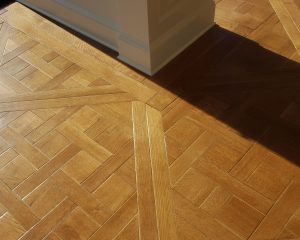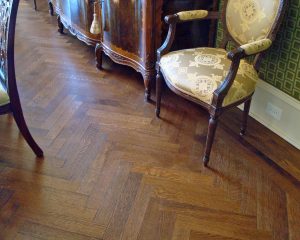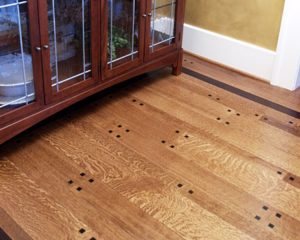 Hardwood floors are, by any measure, the gold standard for flooring. No other material can compete with wood’s universal popularity and timeless appeal. Wood floors look just as comfortable and at home in a rustic cabin as they do in a sleek, modern city apartment. Wood is versatile, easy to own and maintain, and is hands down the most attractive flooring you can own.
Hardwood floors are, by any measure, the gold standard for flooring. No other material can compete with wood’s universal popularity and timeless appeal. Wood floors look just as comfortable and at home in a rustic cabin as they do in a sleek, modern city apartment. Wood is versatile, easy to own and maintain, and is hands down the most attractive flooring you can own.
Wood’s versatility makes it possible to achieve a variety of specialized and unique decorative effects. Here are a few ways to vary your wood flooring to make it more decorative:
Different Wood Types
You can vary the species of wood. Different species have different natural coloring and characteristics. Grain pattern, color, hardness, and ability to take a stain are just a few of the ways wood species differ from one another. A clear maple floor will look smooth and uniform while an oak floor will attract the eye with its bold and interesting grain.
Different Cuts
You can vary the cut of the wood. Wood can be cut into planks in three ways that each give a significantly different effect. Plain sawed wood is made from logs sawed vertically up and down allowing the grain to run across the floorboards. The result is a very traditional, cathedral grain pattern. Quarter sawn wood is made by first cutting a log into four quarters, and then cutting planks that are at 60- to 90-degree angles to the growth rings. The result is a grain pattern that is straight and can contain dramatic flecking. Rift sawn planks are cut perpendicular to growth rings for a gorgeous straight grain with no flecking.
Different Age or Condition
You can vary the age and condition. You can create a floor from newly sawn boards or you can install a floor made from reclaimed lumber. When treated properly, wood is very durable. Floors made from lumber salvaged from historical buildings have a distinctive, imperfect venerable character and warmth.
Different Grades
You can vary the grade. A wood’s grade refers to the features found in the wood’s surface. Clear and select grades are very consistent in color and appearance with no knots, holes, or streaks. Natural and rustic grades have color, knots and surface variations.
Different Widths and Lengths
 You can vary the width and length of the planks. Traditional wood floors were made from strips that were 2 to 3 inches wide, but that is by no means the only option. Thin strips create a modern, almost mosaic feel, and wide planks feel luxurious and spacious. Short, thin strips can be used to create patterns, called parquet, like a herringbone or lozenge to achieve specific decorative effects. Whereas, wide plank flooring in widths from 3 to 10” change the look entirely. Longer boards, for example 2-foot and longer, create a cleaner higher-end floor with less end joints in the field.
You can vary the width and length of the planks. Traditional wood floors were made from strips that were 2 to 3 inches wide, but that is by no means the only option. Thin strips create a modern, almost mosaic feel, and wide planks feel luxurious and spacious. Short, thin strips can be used to create patterns, called parquet, like a herringbone or lozenge to achieve specific decorative effects. Whereas, wide plank flooring in widths from 3 to 10” change the look entirely. Longer boards, for example 2-foot and longer, create a cleaner higher-end floor with less end joints in the field.
Decorative Flooring Ideas
By changing up the species, color, cut, grade, and size of your planks, you can create a decorative wood floor that is unique to you and your home. The options are endless, which is one reason wood remains so popular for flooring. Here are just a few of our favorite decorative wood flooring ideas:
- Wide plank flooring – Wide planks are distinctive and luxurious and create a clean, spacious look. Some species are better for wide planks than others, as wide planks need to be very stable and resistant to humidity. Maple, white ash, walnut, and white oak are among the species that are the most stable when cut into wide planks.
 Patterned flooring – Why have a floor when you can have a work of art? Wood is beautiful, and patterns in your floor can bring out that beauty. Chevrons, herringbones, grids, pegs, and borders can all make your floor a focal point in the design of your room. Best of all, almost any species or cut of wood can be used to create a memorable pattern. Quarter-sawn material creates more stable patterns.
Patterned flooring – Why have a floor when you can have a work of art? Wood is beautiful, and patterns in your floor can bring out that beauty. Chevrons, herringbones, grids, pegs, and borders can all make your floor a focal point in the design of your room. Best of all, almost any species or cut of wood can be used to create a memorable pattern. Quarter-sawn material creates more stable patterns.- Reclaimed antique flooring – Flooring made from re-milled antique wood has a rich and unique patina. Pine and oak are the most common reclaimed species. Antique floors are often visibly hand hewn and rough sawn and have nail holes and other signs of age and use that make them truly distinctive.
Visit Wood & Co. today for other decorative wood flooring ideas!
